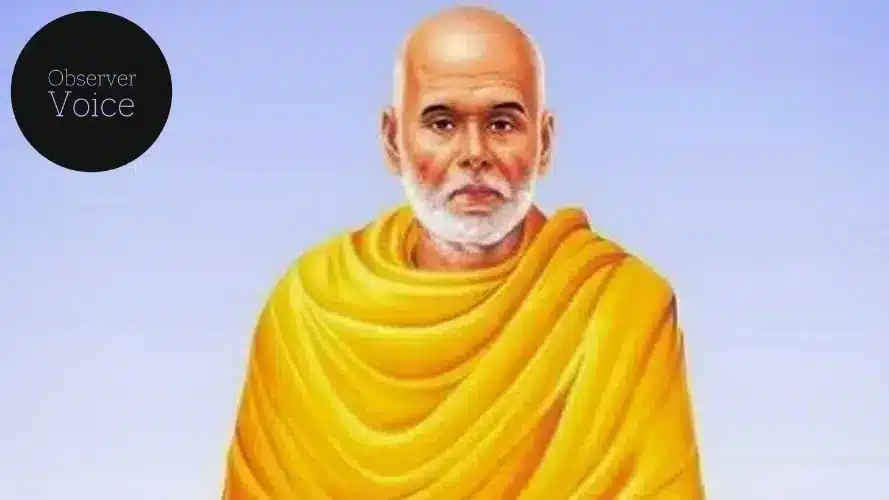Narayana Guru: The Spiritual Reformer of Social Equality

Narayana Guru (20 August 1856 – 20 September 1928) was a philosopher, spiritual leader, and social reformer in India. He led a reform movement against injustice in the caste-ridden society of Kerala in order to promote spiritual enlightenment and social equality.
Life and Career
Narayana Guru was born on 20 August 1856, in Kerala, India. In his childhood, he was always in deep contemplation and loved solitude. He wrote hymns and devotional songs for the temples and was deeply drawn to them.
His education was in a traditional gurukul under Chempazhanthi Mootha Pillai. When he was 21, he traveled to Travancore to learn Sanskrit from Raman Pillai Asan. He taught Narayana Guru Vedas, Upanishads, Sanskrit literature, logic, and rhetoric. Due to his father’s ill health, he abandoned his studies and returned to his village in 1881. “Nanu Asan” set up a small school in the village to teach local kids.
He left his home and village to become a spiritual wanderer. He traveled a lot through Kerala and Tamil Nadu. As he traveled, he got involved with social and religious reformer Chattampi Swamikal, who introduced him to Ayyavu Swamikal, who taught him yoga and meditation.
For eight years he meditated and practiced yoga at Pillathadam cave at Maruthwamala. In 1888, he meditated in Aruvippuram and sanctified a rock from the river as an idol of Shiva, which eventually became known as the Aruvippuram Shiva Temple. He founded ‘Sree Narayana Dharma Paripalana Yogam’ (SNDP) with Padmanabhan Palpu to help underprivileged Ezhavas get spiritual upliftment and education.
He moved to Sivagiri, near Varkala, in 1904, and started a school for low-caste children. He built Sarada Mutt in Sivagiri in 1912. He also built temples in Thrissur, Kozhikode, Anchuthengu, Kannur, Mangalore, and Thalassery, and also traveled to Sri Lanka in 1926.
Fight Against Casteism
In the 19th and early 20th centuries, casteism ruled Indian society. The Brahmins oppressed lower castes like the Thiyyas and Ezhavas, and untouchable castes like Pulayars, Paraiyars, and tribals. He wasn’t spared either, so he erected the Siva idol at Aruvippuram in 1888 as his first act of protest. Over forty-five temples were built by him in Kerala and Tamil Nadu.
Several non-traditional objects were even sanctified by him, including a slab with the inscriptions “Truth, Ethics, Compassion,” a vegetarian Shiva, a mirror, and an Italian sculpture. In his sermons, he preached compassion and tolerance. In one of his important works, Anukampadasakam, he praises Buddha, Krishna, Jesus Christ, and Adi Shankara.
Vaikom Satyagraha
Vaikom Satyagraha started when people from lower castes rebelled against Travancore’s untouchability laws. Narayana Guru was stopped on his way to Vaikom Temple by an upper caste person, which sparked the Vaikom Satyagraha.
Several of Guru’s disciples wrote poems disapproving of the incident, including Muloor S. Padmanabha Panicker and Kumaran Asan. As a result, protesters like K Kelappan and K P Kesava Menon formed a group and declared the Kerala Paryatanam. Mahatma Gandhi also supported the movement. As a result, the temple was opened to everyone, and three roads led to it. The Temple Entry Proclamation of 1936 was influenced by this protest.
Narayana Guru wrote a bunch of spiritual poetry and prayers, like “Atmopadesa Ketakam” and “Daiva Dasakam.” He also translated texts like “Thirukural of Valluvar,” “Ozhivil Odukkam of Kannudaiya Vallalaar,” and “Ishavasya Upanishad.” He died on 20 September 1928, in Kerala, India.
Read More: 16 September: Remembering George Sudarshan on his Birth Anniversary
Observer Voice is the one stop site for National, International news, Sports, Editor’s Choice, Art/culture contents, Quotes and much more. We also cover historical contents. Historical contents includes World History, Indian History, and what happened today. The website also covers Entertainment across the India and World.
Follow Us on Twitter, Instagram, Facebook, & LinkedIn

